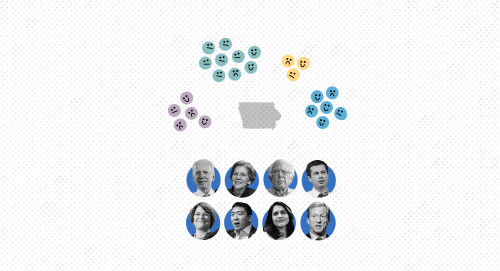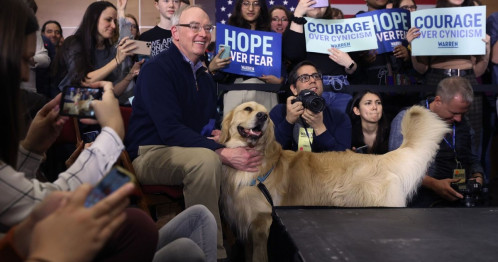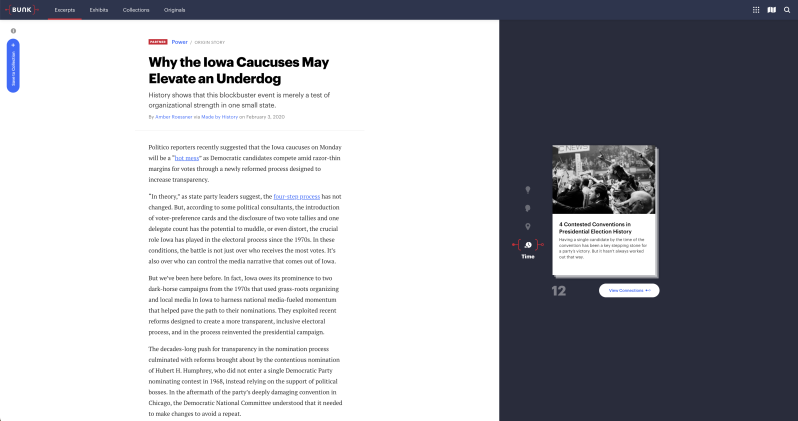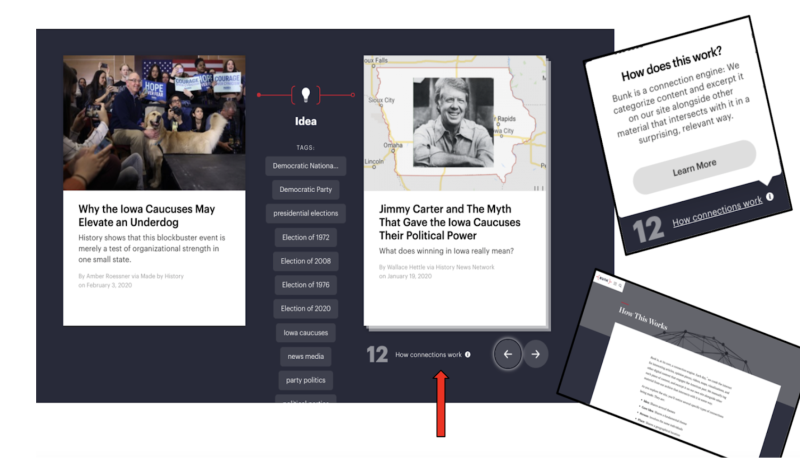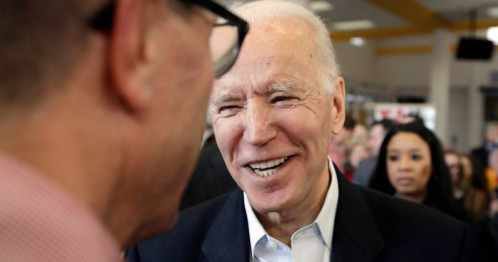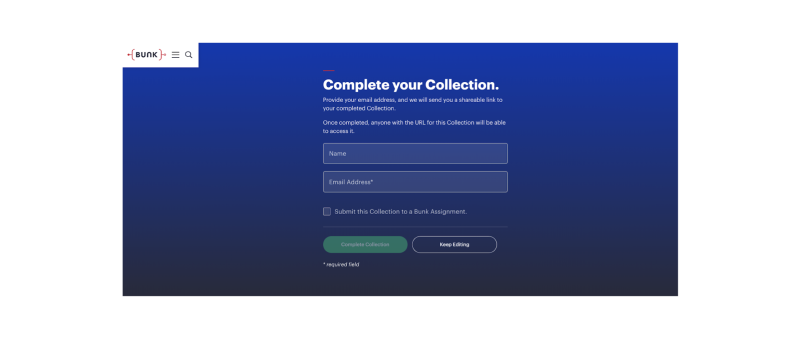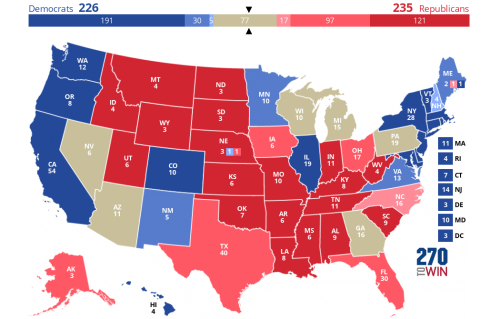This work by New American History is licensed under a Attribution-NonCommercial-ShareAlike 4.0 (CC BY-NC-SA 4.0) International License. Permissions beyond the scope of this license may be available at newamericanhistory.org.
Primaries v. Caucuses
View Student Version
Share this page with your students.
Standards
C3 Framework:D2.Civ.1.6-8. Distinguish the powers and responsibilities of citizens, political parties, interest groups, and the media in a variety of governmental and nongovernmental contexts.D2.Civ.2.6-8. Explain specific roles played by citizens (such as voters, jurors, taxpayers, members of the armed forces, petitioners, protesters, and office-holders). D2.Civ.6.6-8. Describe the roles of political, civil, and economic organizations in shaping people’s lives. D2.Civ.2.9-12. Analyze the role of citizens in the U.S. political system, with attention to various theories of democracy, changes in Americans’ participation over time, and alternative models from other countries, past and present.
National Council for Social Studies:Theme 6: Power, Authority and Governance Theme 10: Civic Ideals and Practices
National Geography Standards: Standard 1—How to use maps and other geographic representations, tools, and technologies to acquire, process, and report information from a spatial perspective
EAD RoadmapTheme: A New Government & ConstitutionDesign Challenges: Motivating Agency, Sustaining the Republic; Civic Honesty, Reflective PatriotismDriving Question: CDQ4.4B
Teacher Tip: Think about what students should be able to KNOW, UNDERSTAND and DO at the conclusion of this learning experience. A brief exit pass or other formative assessment may be used to assess student understandings. Setting specific learning targets for the appropriate grade level and content area will increase student success.
Suggested Grade Levels: Middle / High School (6-8, 9-12)
Suggested Time Frame: 2 periods / 90 minutes each
Suggested Materials: Internet access via laptop, tablet or mobile device, small “ballot box” and slips of paper, 4 pieces of plain paper to make signs for the Vote with Your Feet activity, paper / pencil for the Quick Write and Ballots.
Key Vocabulary
Caucus - party members select the best candidate through a series of discussions and votes
Delegate - votes in a primary election, typically votes how the people vote, then takes these votes to the party’s national convention
Electoral College - representatives of each state who cast the final ballots that actually elect a president
Electorate - citizens who are eligible to vote.
General Election - Election in which voters decide which candidates will actually fill elective public offices.
Incumbent - An elected official who is currently serving in office.
Primary - Election in which voters decide which of the candidates within a party will represent the party in the general election.
Read for Understanding
Teacher Tips:
This Learning Resource was originally developed in collaboration with Made by History, a feature previously published by the Washington Post, and now published in collaboration with TIME magazine. It has been updated for the upcoming 2024 presidential election. Students should have some prior knowledge about the legislative and executive branches of government, including the roles of political parties, and qualifications required in the Constitution of candidates running for the office of President. This Learning Resource includes excerpts of current events from various print and other media sources. A discussion about what it means to take an excerpt or passage of a longer body of work would be helpful before introducing these resources.
It includes an infographic from Kids.gov and a USA Today video explaining the difference between primaries and caucuses. An alternate video from Kids.Gov and an election-themed Ben’s Guide is included in the Lesson Extension which may be more appropriate for younger students, English Language Learners, or other students who may require a simpler option. A second alternate video from The Washington Post includes content specific to the 2020 elections, with more detail for honors or AP classes.
Directions for the Vote with Your Feet activity may be found here. Similar student directions are embedded in the lesson. You may also choose to alter the “candidates” list, or perhaps substitute a quick “mock election” either voting for a class president among the students, Teacher of the Year among the faculty, or use current presidential candidates. These options may require a bit more front-loading of directions so the activity does not become a “popularity contest” or potentially open the door for personal comments about classmates or teachers. Use your best judgment if you choose one of these other options. For this Learning Resource, we recommend more neutral choices using fictional characters.
Directions for the Think, Pair, Share, and Quick Write strategies are linked here and in the student version of the Learning Resources.
For Students:
When a presidential election year rolls around we hear a lot of terms on the news and in discussions, including “primary” and “caucus." This lesson looks at what these two terms mean and why that is important.
Engage:
What is the difference between a primary and a caucus, and why should we care?
Every four years Americans engage in the democratic process of electing the highest office in the United States, the President. You have been studying the branches of government, political parties and the requirements for running for the office of President. In most election years, if the incumbent (current President) has only served one four-year term, they are eligible to run for re-election. The party not currently holding office will engage in a series of political activities known as primaries or caucuses. It varies from state to state, so you will need to examine which procedure your state follows.
Take a few minutes to view this video from USA Today about the election process.
Primary Process:
Your teacher will distribute paper or digital ballots to each student. You will vote, without discussing your views, on the candidates presented.
Your teacher will randomly select 3 students to collect and tally the votes. All other voters should remain seated and quiet during this time. If necessary, a tie-breaker may be held if 2 choices receive the same number of votes. Once a clear winner is determined, the teacher will announce the winner.
Can we Caucus?
Take a look at this animation from Politico to learn about America’s original method of choosing a presidential candidate, the caucus.
Next, you will participate in an activity called Vote with Your Feet. Your teacher will pose the same list of candidates as you voted on with the primary election. This time, your previous choices will be posted on signs in 4-5 distinct locations around the classroom. When your teacher gives you permission, you will immediately go stand under the sign which most closely aligns with your point of view. There should be no discussion, just movement during this time. One everyone is relocated and makes their position known, each group will have one minute to discuss, and 30 seconds to have a spokesperson for the group give an “elevator speech” trying to convince members of the other 2 groups to join their “caucus.” After all 3 groups have pitched their ideas, voters will have 15 seconds to move to another group. If neither group has a 50 majority, a second round of “elevator speeches” may be used to further persuade voters to change their minds. After a 2nd vote, (again, 15 seconds to move—if you so choose) the teacher will determine if another round is needed.
Once your class has finished, you will do a Quick Write and reflect on the 2 activities you just participated in with your classmates.
- Which activity seemed most equitable?
- Did you prefer the paper ballot or the Vote with Your Feet activity more?
Your teacher may ask you to record your answers on an exit ticket.
Explore:
Is the current system of primaries and caucuses still the best option for electing the president?
Examine this infographic (poster) from USA.gov—look very carefully. Think about the previous video you viewed and the voting activities you participated in earlier. The infographic reviews the basic vocabulary and qualifications of the presidential candidates. It also shares information about the next steps after the primaries and caucuses, including the official nominations of candidates at the parties’ national conventions, general elections and the electoral college.
Turn and talk to a partner, discussing your thoughts on the infographic.
- What is the focus of the infographic?
- What is the author’s purpose?
- How does the author demonstrate authority or knowledge of the subject?
- How do the visual elements support understanding or analysis?
- If you could improve this infographic, what might you illustrate differently?
Here is a short video from USA.gov which gives more information about the infographic.
Watch the video first, then discuss these final questions with your partner.
- Now that you know more about the overall process, what is your opinion on the primaries and/or caucuses?
- Should all 50 states and US territories pick one or the other?
- Explain your answer using examples from the video, class activities and/or the infographic.
Your teacher may ask you to record your answers on an exit ticket.
Explain:
What can we learn from historic election patterns?
During the early years of the Republic, caucuses were the preferred way for leaders of the new nation to nominate candidates for elections. Political parties informally began the caucus tradition following George Washington’s second term as the first president. Over time, the caucuses became more complicated and less popular, as the primary process emerged and eventually replaced them in most states. In modern elections, some political analysts and news media have used the earlier primaries and caucuses almost like a weather forecast to try and predict the possible outcomes of these political races.
In 2020, the Washington Post’s Made by History team decided to enlist the help of historians to develop “The Historians’ Guide to 2020,” an ongoing series of history-based articles aimed at exploring the ins, outs and implications of the 2020 election. The first article takes a look at the history of the Iowa caucuses.
Read this excerpt from historian Amber Roessner, Why the Iowa Caucuses May Elevate An Underdog, on Bunk.
Notice the related content to the right of the excerpt. The stack of cards contains other articles, maps or content somehow connected to the original article on the left of the screen. As new content is added to Bunk, the related content and number of cards/connections (indicated by a gray number) will vary.
The connection icons located to the left of the cards here represent Idea, Person, Place and Time, which refers to a connected article from a different time period. These icons and the connected articles you see on the screen may change over time as new content is added to Bunk.
Select the “View Connections” button.
Notice how the screen changes.
Select the “How Connections Work” icon and “Learn More” to read about how Bunk makes connections to its content. Return back to the elections excerpt by using your browser’s back arrow.
Take some time to explore this and other connections to the original excerpt from Historian Amber Roessner. Notice how each of the connections icons (Idea, Place, Person, Time) leads you to a new stack of cards with different articles and topics. Each of these topics in turn has a list of “tags” below the icon to help guide you towards new and different content. Select at least one other icon and/or tag related to elections, primaries or caucuses to explore. Read one or more excerpts of related content you find. If time permits, you may select the “View on...” button to read the full articles on their original sources. (Note: your school may need to support a digital subscription to access some full pieces of content on Bunk).
Use the Think, Pair, Share strategy to reflect on what you read; first on your own, then with a partner, then with another set of partners in a small group.
- What new ideas or insights did the excerpts or articles give you about primaries and caucuses?
- Thinking back to the previous primary/caucus activities you did with your class, and the videos/infographic you studied, has your opinion about either of these partisan election processes changed?
Your teacher may ask you to record your answers on an exit ticket.
Elaborate:
Is the current system of primaries and caucuses still working for American voters?
The primary and caucus system has been a part of U.S. politics since almost the beginning of the nation. Some voters question if the system is broken. Does the election process, including the primaries and caucuses, and nominating conventions really help American citizens select from among the best-qualified candidates, or is the system broken? This second piece from the #HistoriansGuideto2020 delves into these questions. Historian Bruce J. Shulman explores the way these processes have evolved over the years.
View this excerpt on Bunk.
Take some time to explore the connections now that you know how Bunk works! You will be building a collection* of articles to help you answer the question, Is the current system of primaries and caucuses still working for American voters?
To build a collection, you will need to locate the blue Add to Collection button to the left of the excerpt from Historian Bruce J. Schulman.
You will see a box labeled “Add a note.” This is where you will annotate, or write a brief description of how this excerpt helps you answer the question. Be sure to save your note using the green Save Note button. If you decide you want to remove an excerpt from your collection, you can return to the excerpt and select the red “Remove from Collection button.
Continue adding 3-5 excerpts to your collection, exploring the connections on Bunk and annotating each one. Be sure you are saving as you go along. Once you are finished, you may locate the blue bar at the bottom of your screen and select finalize. You MUST save and finish this during one class period.
You will need to give your collection a title, and add your name and teacher’s name/class period. You may reorder the excerpts, and edit or delete a note or excerpt until you are satisfied with your work. Be sure you SAVE CHANGES before you select the green Complete Collection button.
You will need to use an email address to share or retrieve your collection. For safety reasons, your teacher may choose to have you use their school email address, or they may use the Assignment feature instead of Collections on Bunk.
Keep checking back on Bunk for new content being added to follow the 2024 elections. You can search for related tags such as “elections,” “candidates,” “primaries, or others you are interested in following. New content is added to Bunk every day!
This map from 270 to Win may be a useful guide as you continue to follow the election process.
Your teacher may ask you to record your answers on an exit ticket.
*(Note: Your teacher may prefer you to complete an assignment they created in Bunk if your school does not allow students to access email. This is similar to the Collections feature in Bunk)..
Extend:
Where might we find more information specific to the next presidential election?
The following list of curated resources may be used to track primary and caucus results and compare and contrast party platforms and candidates' positions on a variety of campaign issues.
For K-8 students:
Ben’s Guide Election of the President & Vice President: Primary Election
Kids.gov Becoming President: Primaries and Caucuses
For High School, Advanced Placement, Dual Enrollment, or Honors courses:
BackStory: History of Political Parties Splintered Parties
Washington Post Elections: video on Primaries Why do we do it this way? Explaining America’s presidential primary system?
Citations:
“270TOWIN - 2024 Presidential Election Interactive Map.” 270toWin.com, 2024. https://www.270towin.com/maps/consensus-2024-presidential-election-forecast.
"An Illustrated Guide To The Iowa Caucuses". 2020. Politico.Com. https://www.politico.com/interactives/2020/iowa-caucus-how-they-work/.
"Becoming President: Primaries And Caucuses". 2020. You Tube. https://www.youtube.com/watch?v=ll1QFMWj8VE.
"Caucus V. Primary: What's The Difference?". 2020. Youtube. https://www.youtube.com/watch?v=6_gA766lT3c.
Davis, Katy. “Election of the President and Vice President: Primary Election.” Ben's Guide. Government Publishing Office, n.d. https://bensguide.gpo.gov/election-of-the-president-vice-president-primary-election.
"Presidential Election Process | USA.gov". 2020. USA.Gov. https://www.usa.gov/election#item-212481.
“Quick Write/Quick Draw - Readwritethink.” Read Write Think, 2007. https://www.readwritethink.org/sites/default/files/resources/lesson_images/lesson1053/quick_write_draw.pdf.
Shulman, Bruce J. “A Century of Reforms Made Iowa and New Hampshire Presidential Kingmakers.” Bunk History. Washington Post, February 3, 2020. https://www.bunkhistory.org/resources/perspective-a-century-of-reforms-made-iowa-and-new-hampshire-presidential-kingmakers-2
Roessner, Amber. 'Why the Iowa Caucuses May Elevate an Underdog', Made by History, February 3, 2020 https://www.bunkhistory.org/resources/perspective-why-the-iowa-caucuses-may-elevate-an-underdog
“Splintered Parties.” BackStory. Virginia Humanities, June 13, 2014. https://backstory.newamericanhistory.org/search?query=splintered.
"Vote With Your Feet". 2020. Youtube. https://www.youtube.com/watch?v=cQzlL7KkVcI.
"Why Do We Do It This Way? Explaining America’s Presidential Primary System". 2020. Washington Post Election 2020. https://www.washingtonpost.com/video/politics/why-do-we-do-it-this-way-explaining-americas-presidential-primary-system/2020/02/02/accdaa12-1b04-4ee6-b566-36bbdb719906_video.html.
View this Learning Resource as a Google Doc



